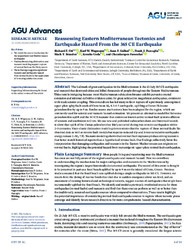Reassessing Eastern Mediterranean Tectonics and Earthquake Hazard From the 365 CE Earthquake
Ott, Richard F.; Wegmann, Karl W.; Gallen, Sean F.; Pazzaglia, Frank J.; Brandon, Mark T.; Ueda, Kosuke; Fassoulas, Charalampos, 2021: Reassessing Eastern Mediterranean Tectonics and Earthquake Hazard From the 365 CE Earthquake. In: AGU Advances, Band 2, 2, DOI: 10.23689/fidgeo-4346.
 |
Dokument öffnen: |
The hallmark of great earthquakes in the Mediterranean is the 21 July 365 CE earthquake and tsunami that destroyed cities and killed thousands of people throughout the Eastern Mediterranean. This event is intriguing because most Mediterranean subduction forearcs exhibit pervasive crustal extension and minimal definitive evidence exists for great subduction megathrust earthquakes, consistent with weak seismic coupling. This conundrum has led many to favor rupture of a previously unrecognized upper plate splay fault south of Crete in an M
w 8.3–8.5 earthquake, uplifting a Cretan Holocene paleoshoreline by up to 9 m. Similar source mechanisms have been adapted for the region, which are commonly used for seismic and tsunami hazard estimation. We present an alternative model for Holocene paleoshoreline uplift and the 365 CE tsunami that centers on known active normal fault systems offshore of western and southwestern Crete. We use new and published radiocarbon dates and historical records to show that uplift of the Cretan paleoshoreline likely occurred during two or more earthquakes within 2–3 centuries. Visco‐elastic dislocation modeling demonstrates that the rupture of these normal faults fits observed data as well as reverse fault models but requires reduced slip and lower cumulative earthquake energy release (∼M
w 7.9). Tsunami modeling shows that normal‐fault ruptures produce strong tsunamis that better match historical reports than a hypothetical reverse fault. Our findings collectively favor the interpretation that damaging earthquakes and tsunamis in the Eastern Mediterranean can originate on normal faults, highlighting the potential hazard from tsunamigenic upper plate normal fault earthquakes. Plain Language Summary:
Most people living and vacationing near the Mediterranean Sea coast are not fully aware of the region's earthquake and tsunami hazard. Here we contribute to understanding the mechanisms for major earthquakes and tsunamis in the Mediterranean by investigating the region's largest historically documented earthquake. The record of this event is thought to be preserved in part as a fossil beach uplifted by up to 9 m on the island of Crete, Greece. Previous studies assumed that the fossil beach was uplifted during a single earthquake in 365 CE. However, our results from the dating of marine fossils that died due to sudden emergence above sea level, and an assessment of existing historical and archeological records, suggest a series of earthquakes that might have incrementally uplifted the fossil beach. We identify and model a previously overlooked source for these earthquakes (normal faults) and tsunamis and find that these sources perform as well as or better than the traditionally assumed earthquake sources when compared to observations. These results highlight the potential importance of considering normal‐fault earthquake sources in regions where tectonic plates converge and identify future research directions for more comprehensive hazard characterization. Key Points:
We revisit the source mechanism for the largest historical Mediterranean earthquake.
Radiocarbon dating, dislocation, and tsunami modeling support rupture of normal faults as the likely source.
These findings suggest a significant tsunami and earthquake hazard from normal faults in the upper plate of retreating subduction zones.
Statistik:
ZugriffsstatistikSammlung:
Schlagworte:
365 CE earthquakedislocation modeling
Mediterranean
seismic hazard
tectonics
tsunami modeling
This is an open access article under the terms of the Creative Commons Attribution License, which permits use, distribution and reproduction in any medium, provided the original work is properly cited.

